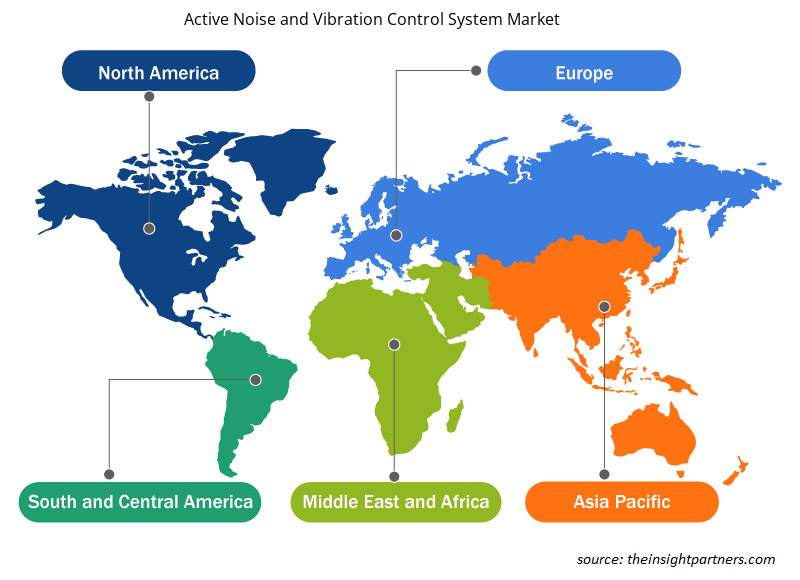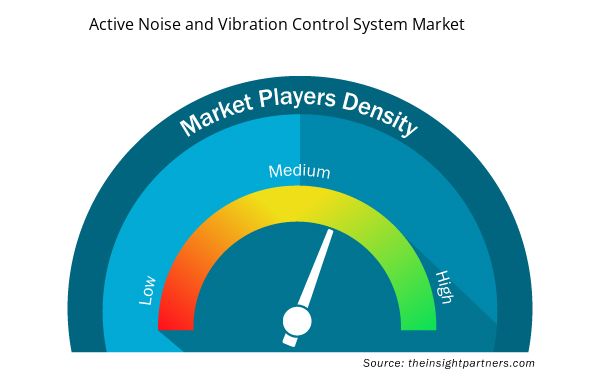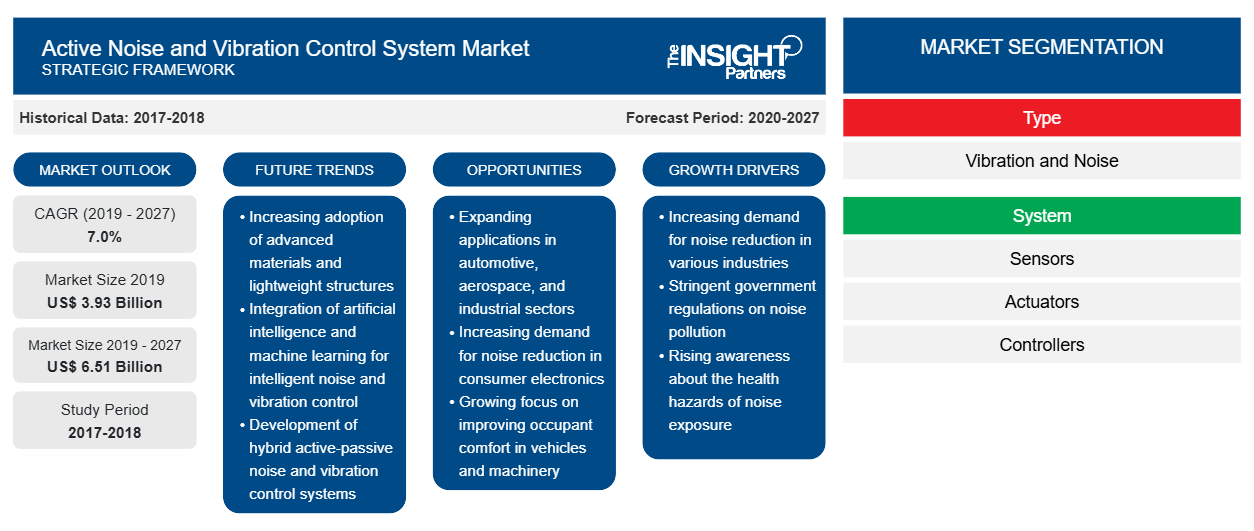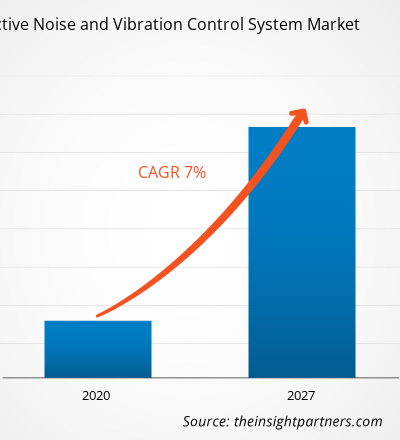In termini di fatturato, il mercato globale dei sistemi di controllo attivo del rumore e delle vibrazioni è stato valutato a 3.925,61 milioni di dollari nel 2019 e si prevede che raggiungerà i 6.505,28 milioni di dollari entro il 2027; si prevede una crescita a un CAGR del 7,0% nel periodo di previsione dal 2020 al 2027.
Il mercato dei sistemi di controllo attivo del rumore e delle vibrazioni è ampiamente segmentato in cinque regioni principali: Nord America, Europa, APAC , MEA e SAM. L'industria aerospaziale e della difesa in Nord America è maturata con l'esistenza di un gran numero di produttori di aeromobili e il continuo supporto del Dipartimento della Difesa degli Stati Uniti . La domanda di tecnologie avanzate è enorme nella regione, con tutti gli utenti finali sopra menzionati che sono ben consapevoli delle nuove tecnologie. Il Dipartimento della Difesa degli Stati Uniti investe continuamente tempo e denaro nei progressi della flotta esistente e nello sviluppo di veicoli corazzati terrestri con tecnologia robusta e di imbarcazioni marine con l'obiettivo di mantenere una forza pronta per la missione. La presenza di un gran numero di produttori di sistemi di controllo attivo del rumore e delle vibrazioni nella regione supporta la domanda in continua crescita, che sta quindi aumentando il mercato dei sistemi di controllo attivo del rumore e delle vibrazioni
Personalizza questo report in base alle tue esigenze
Riceverai la personalizzazione gratuita di qualsiasi report, comprese parti di questo report, o analisi a livello nazionale, pacchetto dati Excel, oltre a usufruire di grandi offerte e sconti per start-up e università
- Scopri le principali tendenze di mercato in questo rapporto.Questo campione GRATUITO includerà analisi di dati che spaziano dalle tendenze di mercato alle stime e alle previsioni.
Approfondimenti di mercato: mercato dei sistemi di controllo attivo del rumore e delle vibrazioni
Crescente adozione di sistemi attivi nella produzione ferroviaria
L'industria ferroviaria in tutto il mondo sta crescendo a un ritmo considerevole nel corso degli anni, con diversi progressi tecnologici in corso che riflettono viaggi più sicuri e confortevoli. Le apparecchiature ferroviarie (carrelli e carrelli di carico) subiscono significative vibrazioni verticali e rumore, che aumentano diversi tipi di rischio durante le operazioni. Per sopprimere le vibrazioni e il rumore, diversi produttori di apparecchiature ferroviarie si stanno concentrando sempre di più sull'adozione di sistemi di controllo del rumore e delle vibrazioni. Il controllo passivo del rumore e delle vibrazioni è prevalente tra i produttori di ferrovie poiché questi sistemi consentono ai produttori di offrire ai propri clienti prodotti più sicuri e confortevoli. Tuttavia, la maggior parte dei sistemi passivi sono sistemi idraulici e negli ultimi anni i produttori di apparecchiature ferroviarie stanno enfatizzando i sistemi controllati elettronicamente/elettricamente, il che riflette l'aumento dell'attrazione verso i sistemi attivi di rumore e vibrazioni. Un sistema attivo con attuatori di massa inerziale montati sui carrelli può controllare il rumore e le vibrazioni a bassa frequenza all'interno dei compartimenti. Inoltre, i sistemi attivi sono generalmente sistemi elettromeccanici , che stanno diventando la preferenza chiave tra i produttori di apparecchiature ferroviarie. Si prevede che questo fattore genererà una domanda significativamente più elevata di sistemi attivi tra i produttori di apparecchiature ferroviarie, catalizzando così il mercato dei sistemi di controllo attivo del rumore e delle vibrazioni.
Tipo Segmento Insights
In base al tipo, il segmento delle vibrazioni ha dominato il mercato globale dei sistemi di controllo attivo del rumore e delle vibrazioni nel 2019. I sistemi di controllo attivo delle vibrazioni sono sistemi di isolamento che rispondono dinamicamente alle vibrazioni esterne. Questi sistemi sono utilizzati per ridurre l'attrito e controllare le vibrazioni nelle macchine in movimento o statiche.
Informazioni dettagliate sui segmenti di sistema
In base al sistema, il segmento degli attuatori ha dominato il mercato globale dei sistemi di controllo attivo del rumore e delle vibrazioni nel 2019. Gli attuatori sono integrati nei sistemi di controllo attivo del rumore e delle vibrazioni per controllare varie forze all'interno dell'impianto per migliorare il funzionamento complessivo. Questi attuatori utilizzano diverse tecnologie come piezoelettrica, elettrodinamica ed elettrodinamica idraulica.
Approfondimenti sui segmenti industriali
In base al settore, il segmento aerospaziale ha dominato il mercato globale dei sistemi di controllo attivo del rumore e delle vibrazioni nel 2019. L'industria aerospaziale sta prosperando a un ritmo esponenziale nel corso degli anni con un gran numero di produzioni e consegne. I produttori di aeromobili e i produttori di componenti stanno assistendo a pressioni significative da parte degli utenti finali del settore dell'aviazione commerciale per fornire un numero maggiore di aeromobili.
Gli operatori del mercato si concentrano sulle innovazioni e sugli sviluppi di nuovi prodotti integrando tecnologie e funzionalità avanzate nei loro prodotti per competere con i concorrenti.
- Nel 2019, Creo Dynamics ha annunciato l'acquisizione della sua quota di maggioranza da parte di Faurecia, per unire le competenze dell'azienda nel controllo attivo del rumore e nell'acustica nel settore automobilistico con Faurecia e sviluppare nuove soluzioni esclusive per il mercato.
- Nel 2019, Terma ha annunciato di aver firmato un contratto con UASF per la fornitura di sistemi audio 3D per gli aerei A-10.
- Nel 2018, Vicoda GmbH ha annunciato di aver fornito smorzatori di massa accordati per passerelle pedonali a Gent per controllare e ridurre le vibrazioni indotte dai pedoni e soddisfare i requisiti di comfort impedendo l'effetto "lock-in".
Il mercato globale dei sistemi di controllo attivo del rumore e delle vibrazioni è stato segmentato come segue:
Approfondimenti regionali sul mercato dei sistemi di controllo attivo del rumore e delle vibrazioni
Le tendenze regionali e i fattori che influenzano il mercato dei sistemi di controllo attivo del rumore e delle vibrazioni durante il periodo di previsione sono stati ampiamente spiegati dagli analisti di Insight Partners. Questa sezione discute anche i segmenti di mercato dei sistemi di controllo attivo del rumore e delle vibrazioni e la geografia in Nord America, Europa, Asia Pacifico, Medio Oriente e Africa e Sud e Centro America.

- Ottieni i dati specifici regionali per il mercato dei sistemi di controllo attivo del rumore e delle vibrazioni
Ambito del rapporto di mercato sui sistemi di controllo attivo del rumore e delle vibrazioni
| Attributo del report | Dettagli |
|---|---|
| Dimensioni del mercato nel 2019 | 3,93 miliardi di dollari USA |
| Dimensioni del mercato entro il 2027 | 6,51 miliardi di dollari USA |
| CAGR globale (2019 - 2027) | 7,0% |
| Dati storici | 2017-2018 |
| Periodo di previsione | 2020-2027 |
| Segmenti coperti | Per tipo
|
| Regioni e Paesi coperti | America del Nord
|
| Leader di mercato e profili aziendali chiave |
|
Densità degli attori del mercato: comprendere il suo impatto sulle dinamiche aziendali
Il mercato dei sistemi di controllo attivo del rumore e delle vibrazioni sta crescendo rapidamente, spinto dalla crescente domanda degli utenti finali dovuta a fattori quali l'evoluzione delle preferenze dei consumatori, i progressi tecnologici e una maggiore consapevolezza dei vantaggi del prodotto. Con l'aumento della domanda, le aziende stanno ampliando le loro offerte, innovando per soddisfare le esigenze dei consumatori e capitalizzando sulle tendenze emergenti, il che alimenta ulteriormente la crescita del mercato.
La densità degli operatori di mercato si riferisce alla distribuzione di aziende o società che operano in un particolare mercato o settore. Indica quanti concorrenti (operatori di mercato) sono presenti in un dato spazio di mercato in relazione alle sue dimensioni o al valore di mercato totale.
Le principali aziende che operano nel mercato dei sistemi di controllo attivo del rumore e delle vibrazioni sono:
- Honeywell International Inc.
- Società a responsabilità limitata
- Azienda
- Società Parker Hannifin
- Faurecia Creo AB
Disclaimer : le aziende elencate sopra non sono classificate secondo un ordine particolare.

- Ottieni una panoramica dei principali attori del mercato dei sistemi di controllo attivo del rumore e delle vibrazioni
Mercato dei sistemi di controllo attivo del rumore e delle vibrazioni – Per tipo
- Vibrazione
- Rumore
Mercato dei sistemi di controllo attivo del rumore e delle vibrazioni – Per sistema
- Sensori
- Attuatori
- Controllori
- Ammortizzatori
Mercato dei sistemi di controllo attivo del rumore e delle vibrazioni – Per sistema
- Aerospaziale
- Ala fissa
- Ala rotante
- Difesa
- Veicolo terrestre
- Navi militari
- Ferrovia
- Industrie generali
- Produzione
- Energia e potenza
Mercato dei sistemi di controllo attivo del rumore e delle vibrazioni – Per sistema
- Sensori
- Attuatori
- Controllori
- Ammortizzatori
Mercato dei sistemi di controllo attivo del rumore e delle vibrazioni - Per regione
- America del Nord
- NOI
- Canada
- Messico
- Europa
- Francia
- Germania
- Italia
- Regno Unito
- Russia
- Resto d'Europa
- Asia Pacifico (APAC)
- Cina
- India
- Corea del Sud
- Giappone
- Australia
- Resto dell'APAC
- Medio Oriente e Africa (MEA)
- Sudafrica
- Arabia Saudita
- Emirati Arabi Uniti
- Resto del MEA
- America del Sud (SAM)
- Brasile
- Resto del SAM
Mercato dei sistemi di controllo attivo del rumore e delle vibrazioni – Profili aziendali
- FABBRICA
- Honeywell International Inc.
- GIOCO
- Terma A/S
- Azienda
- Parker Hannifin
- Faurecia Creo AB
- Supershock
- Trelleborg AB
- VICODA GmbH
- Analisi storica (2 anni), anno base, previsione (7 anni) con CAGR
- Analisi PEST e SWOT
- Valore/volume delle dimensioni del mercato - Globale, regionale, nazionale
- Industria e panorama competitivo
- Set di dati Excel


- Artificial Intelligence in Defense Market
- Artificial Intelligence in Healthcare Diagnosis Market
- Tortilla Market
- Vessel Monitoring System Market
- Hot Melt Adhesives Market
- Integrated Platform Management System Market
- Fishing Equipment Market
- Thermal Energy Storage Market
- Glycomics Market
- Medical and Research Grade Collagen Market

Report Coverage
Revenue forecast, Company Analysis, Industry landscape, Growth factors, and Trends

Segment Covered
This text is related
to segments covered.

Regional Scope
North America, Europe, Asia Pacific, Middle East & Africa, South & Central America

Country Scope
This text is related
to country scope.
Domande frequenti
The aerospace and defense industry in North America is matured with the existence of a large number of aircraft manufacturers, and continuous support from the US DoD. The demand for advanced technologies is tremendous in the region, with all the end users mentioned above are well aware of newer technologies. The US DoD continuously invests time and amounts towards the advancements of existing fleet and development of robust technology ground armored vehicles as well as marine vessel with an objective to maintain a mission-ready force. The presence of a large number of active noise and vibration control system manufacturers in the region is supporting the ever-rising demand, which is thereby boosting the active noise and vibration control system market.
The actuators segment capture maximum share in active noise and vibration control system market. The actuators in the active vibration control system are used to reduce vibrations produced in the machines; however, they are also used as shakers in the active isolation system. These actuators are connected to the sensors and are available in the same number, orientation, and location as that of the sensors The actuators reduce the incoming vibrations, thereby permitting the load on the intact system.
The aviation industry is maturing at a rapid rate over the years, recording a significant number of production and deliveries of aircraft (commercial and military) fleet (fixed wing and rotary wing). However, the aircraft manufacturers are heavily challenged on decreasing the overall weight of any aircraft. The active noise and vibration control systems offer significant weight reduction capability as compared with its passive counterparts. This factor is increasing the interest among the end users to adopt the technology.
Trends and growth analysis reports related to Aerospace and Defense : READ MORE..
The List of Companies - Active Noise and Vibration Control System Market
- Honeywell International Inc.
- Fabreeka International Inc.
- Moog Inc.
- Parker Hannifin Corporation
- Faurecia Creo AB
- Supashock Advanced Technologies
- Trellborg AB
- Hutchinson
- Terma A/S
- Vicoda GmbH
The Insight Partners performs research in 4 major stages: Data Collection & Secondary Research, Primary Research, Data Analysis and Data Triangulation & Final Review.
- Data Collection and Secondary Research:
As a market research and consulting firm operating from a decade, we have published and advised several client across the globe. First step for any study will start with an assessment of currently available data and insights from existing reports. Further, historical and current market information is collected from Investor Presentations, Annual Reports, SEC Filings, etc., and other information related to company’s performance and market positioning are gathered from Paid Databases (Factiva, Hoovers, and Reuters) and various other publications available in public domain.
Several associations trade associates, technical forums, institutes, societies and organization are accessed to gain technical as well as market related insights through their publications such as research papers, blogs and press releases related to the studies are referred to get cues about the market. Further, white papers, journals, magazines, and other news articles published in last 3 years are scrutinized and analyzed to understand the current market trends.
- Primary Research:
The primarily interview analysis comprise of data obtained from industry participants interview and answers to survey questions gathered by in-house primary team.
For primary research, interviews are conducted with industry experts/CEOs/Marketing Managers/VPs/Subject Matter Experts from both demand and supply side to get a 360-degree view of the market. The primary team conducts several interviews based on the complexity of the markets to understand the various market trends and dynamics which makes research more credible and precise.
A typical research interview fulfils the following functions:
- Provides first-hand information on the market size, market trends, growth trends, competitive landscape, and outlook
- Validates and strengthens in-house secondary research findings
- Develops the analysis team’s expertise and market understanding
Primary research involves email interactions and telephone interviews for each market, category, segment, and sub-segment across geographies. The participants who typically take part in such a process include, but are not limited to:
- Industry participants: VPs, business development managers, market intelligence managers and national sales managers
- Outside experts: Valuation experts, research analysts and key opinion leaders specializing in the electronics and semiconductor industry.
Below is the breakup of our primary respondents by company, designation, and region:

Once we receive the confirmation from primary research sources or primary respondents, we finalize the base year market estimation and forecast the data as per the macroeconomic and microeconomic factors assessed during data collection.
- Data Analysis:
Once data is validated through both secondary as well as primary respondents, we finalize the market estimations by hypothesis formulation and factor analysis at regional and country level.
- Macro-Economic Factor Analysis:
We analyse macroeconomic indicators such the gross domestic product (GDP), increase in the demand for goods and services across industries, technological advancement, regional economic growth, governmental policies, the influence of COVID-19, PEST analysis, and other aspects. This analysis aids in setting benchmarks for various nations/regions and approximating market splits. Additionally, the general trend of the aforementioned components aid in determining the market's development possibilities.
- Country Level Data:
Various factors that are especially aligned to the country are taken into account to determine the market size for a certain area and country, including the presence of vendors, such as headquarters and offices, the country's GDP, demand patterns, and industry growth. To comprehend the market dynamics for the nation, a number of growth variables, inhibitors, application areas, and current market trends are researched. The aforementioned elements aid in determining the country's overall market's growth potential.
- Company Profile:
The “Table of Contents” is formulated by listing and analyzing more than 25 - 30 companies operating in the market ecosystem across geographies. However, we profile only 10 companies as a standard practice in our syndicate reports. These 10 companies comprise leading, emerging, and regional players. Nonetheless, our analysis is not restricted to the 10 listed companies, we also analyze other companies present in the market to develop a holistic view and understand the prevailing trends. The “Company Profiles” section in the report covers key facts, business description, products & services, financial information, SWOT analysis, and key developments. The financial information presented is extracted from the annual reports and official documents of the publicly listed companies. Upon collecting the information for the sections of respective companies, we verify them via various primary sources and then compile the data in respective company profiles. The company level information helps us in deriving the base number as well as in forecasting the market size.
- Developing Base Number:
Aggregation of sales statistics (2020-2022) and macro-economic factor, and other secondary and primary research insights are utilized to arrive at base number and related market shares for 2022. The data gaps are identified in this step and relevant market data is analyzed, collected from paid primary interviews or databases. On finalizing the base year market size, forecasts are developed on the basis of macro-economic, industry and market growth factors and company level analysis.
- Data Triangulation and Final Review:
The market findings and base year market size calculations are validated from supply as well as demand side. Demand side validations are based on macro-economic factor analysis and benchmarks for respective regions and countries. In case of supply side validations, revenues of major companies are estimated (in case not available) based on industry benchmark, approximate number of employees, product portfolio, and primary interviews revenues are gathered. Further revenue from target product/service segment is assessed to avoid overshooting of market statistics. In case of heavy deviations between supply and demand side values, all thes steps are repeated to achieve synchronization.
We follow an iterative model, wherein we share our research findings with Subject Matter Experts (SME’s) and Key Opinion Leaders (KOLs) until consensus view of the market is not formulated – this model negates any drastic deviation in the opinions of experts. Only validated and universally acceptable research findings are quoted in our reports.
We have important check points that we use to validate our research findings – which we call – data triangulation, where we validate the information, we generate from secondary sources with primary interviews and then we re-validate with our internal data bases and Subject matter experts. This comprehensive model enables us to deliver high quality, reliable data in shortest possible time.


 Ottieni un campione gratuito per questo repot
Ottieni un campione gratuito per questo repot